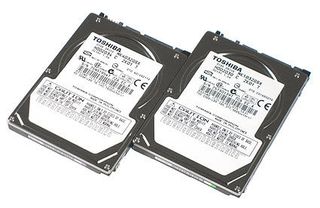New Toshiba SATA Drives Lack Performance Increase
SATA Alone Won't Do

Nine months ago, Intel presented its current mobile platform called Sonoma, offering support for Serial ATA (SATA) hard drives in notebooks for the first time. But acceptance of SATA is still poor today, because there is no urgent need for it from a performance point of view. While fast desktop drives do benefit from SATA features such as high interface bandwidth and command queuing, the notebook versions don't present impressive numbers, mostly because their rotation speeds are still slow.
Still, SATA is clearly the interface of the future, as its robust connectors enable notebook designs to be more flexible. This may help to design solutions that, for example, allow for easy exchange of a hard drive. Once Serial ATA finally discards its price penalty, it might even help to save some costs for notebook makers.
All important drive makers already offer Serial ATA versions of their notebook drives. Some probably only do it for the sake of being in the market, while others deliberately target high-density server markets where 2.5" drives are the only way of reducing the space required. Fujitsu has some MHV family members with SATA; Hitachi's TravelStar family has several SATA versions; Samsung released SpinPoint M60 series drives; Seagate offers the Momentum 5400.2 and 7200.1 types with SATA; and finally, Toshiba adds the GSX drives to its portfolio.
However, the GSX family is not based on new technology. Rather, Toshiba took their existing GAX drives and changed the interface to support Serial ATA 150. As a result, the Toshiba SATA drives cannot deliver any more performance than their predecessors. What's more, we wonder whether the performance level will be good enough to keep pace with strong competition.
Stay on the Cutting Edge
Join the experts who read Tom's Hardware for the inside track on enthusiast PC tech news — and have for over 25 years. We'll send breaking news and in-depth reviews of CPUs, GPUs, AI, maker hardware and more straight to your inbox.
Most Popular

